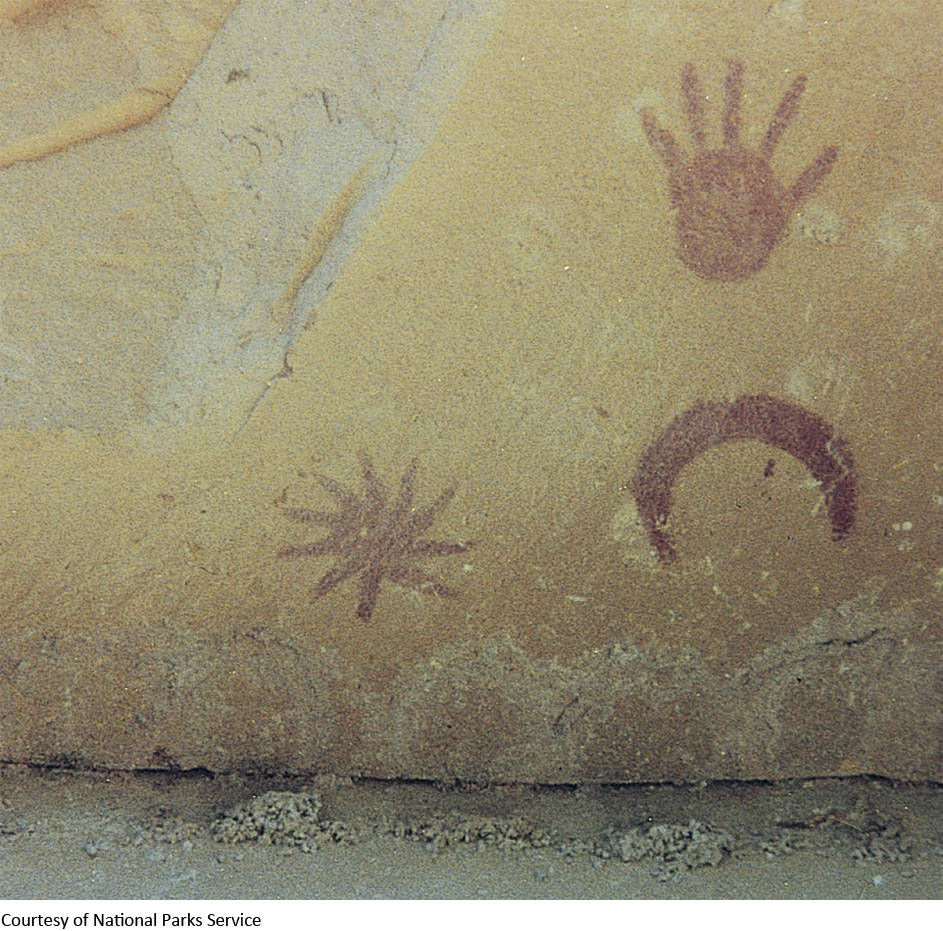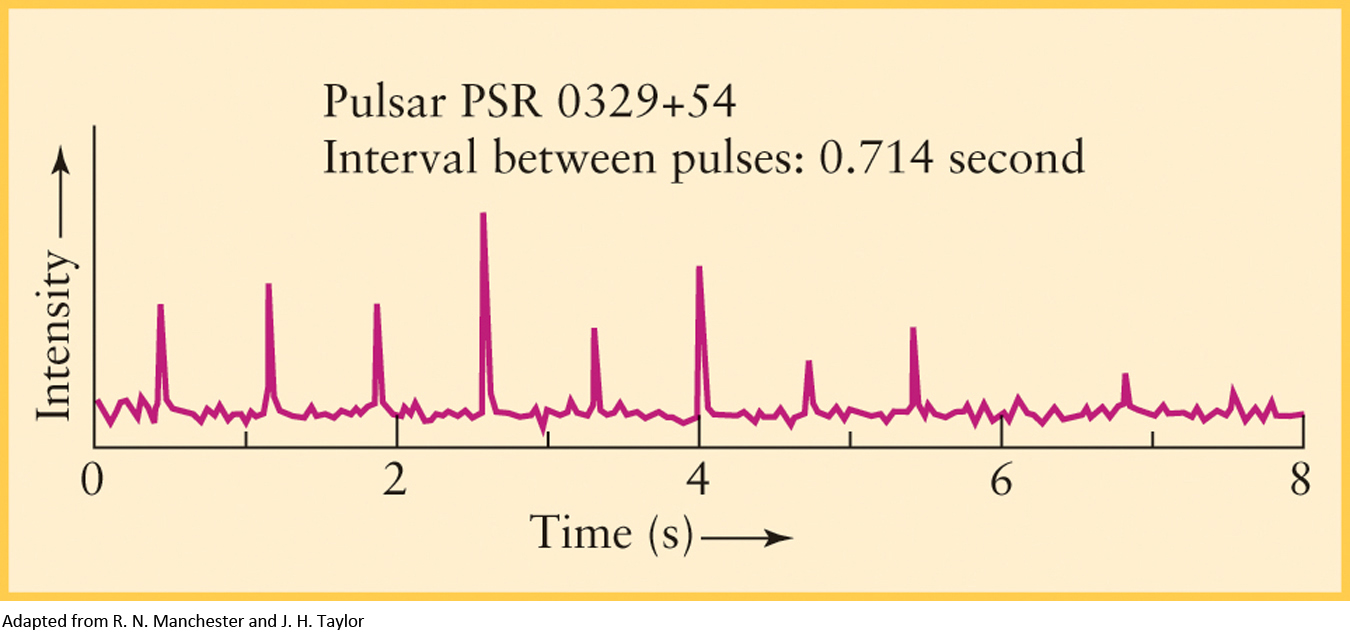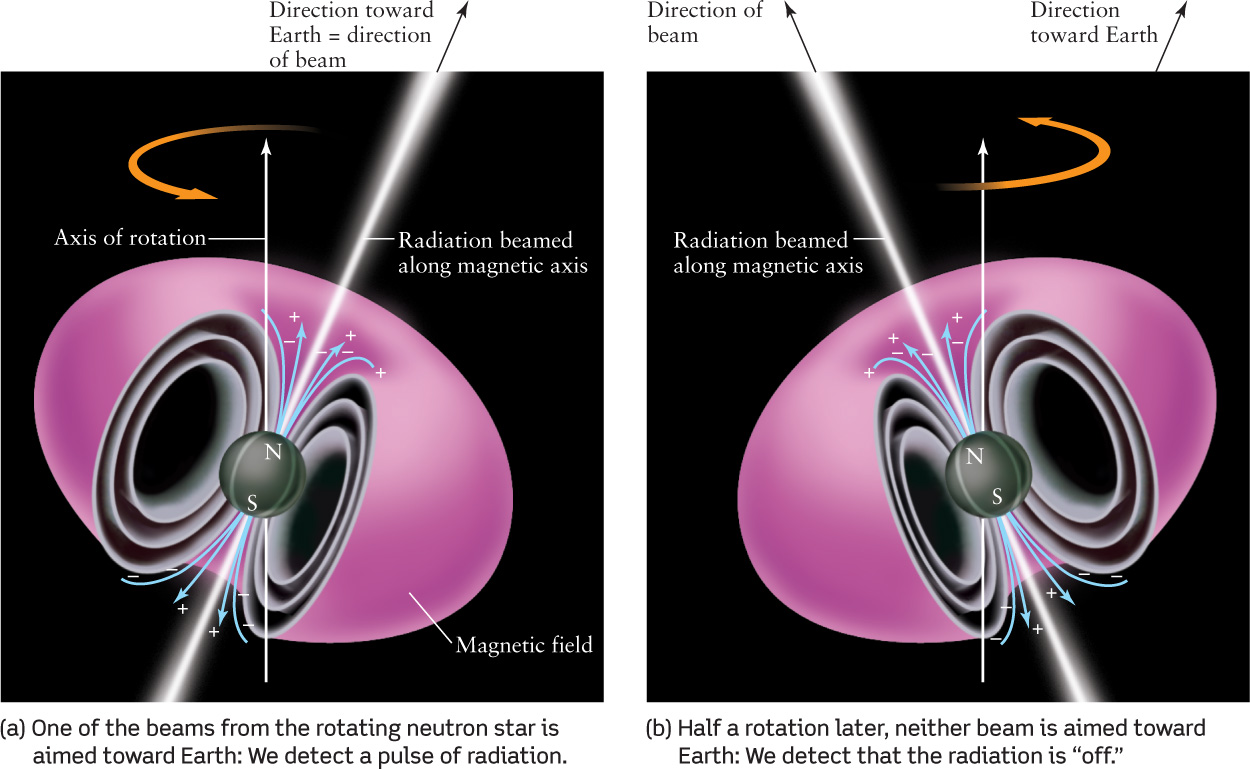12-2 Core-collapse supernovae can leave behind remnants, neutron stars, and pulsars
There is considerable debris left over from the explosion of a core-collapse supernova. Star parts are scattered in every direction, as remnants, and the leftover crushed stellar core forms tiny objects, including neutron stars and pulsars, each with bizarre properties of their own. Let’s consider each of these in turn; then, in the next section, we will turn to the most dramatic remnant of all: black holes.
Supernova Remnants
Astronomers find the remains from exploded massive stars’ outer atmospheres, called supernova remnants, scattered across the sky. A beautiful example of a supernova remnant is the Veil Nebula, shown in Figure 12-7. The doomed star’s outer layers were blasted into space with such violence that they are still traveling through the interstellar medium at supersonic speeds 15,000 years later. As this expanding shell of gas plows through space, it collides with atoms in the interstellar medium, exciting the gas and making it glow. We saw in Section 11-1 that the passage of a supernova remnant through the interstellar medium can trigger the formation of new stars, so the death of a single massive star can cause a host of new stars to be born.

An exploding supernova is bright for several months before fading from view.
Many supernova remnants are virtually invisible at the visible wavelengths our human eyes can see. However, when the expanding gases collide with the interstellar medium, they emit energy at a wide range of wavelengths, from X-rays through radio waves. As a rule, radio searches for supernova remnants are more fruitful than visible-light searches. Only two dozen supernova remnants have been found in visible-light images, but more than 100 remnants have been discovered by radio astronomers.
286
In general, there are only a few supernova remnants in our local neighborhood. At first glance, this apparent lack of nearby supernovae may seem puzzling. From the frequency with which supernovae occur in distant galaxies, it is reasonable to suppose that a galaxy such as our own should have as many as five supernovae per century. Where have they been?
The cores of the most massive stars are crushed in a supernova leaving behind small but exotic objects.
As we will learn when we study galaxies in Chapter 13, the plane of our Galaxy is where massive stars are born and supernovae explode. This region is so rich in interstellar dust, however, that we simply cannot see very far into space in the directions occupied by the Milky Way. In other words, supernovae probably do in fact erupt every few decades in remote parts of our Galaxy, but their detonations are hidden from our view by intervening interstellar matter.
Question
ConceptCheck 12-5: In which wavelength will an expanding supernova remnant most easily be seen if it is in a region of the galaxy with virtually no interstellar gas or dust around it?
Relics of the Fall: Neutron Stars
In some cases, a supernova remnant may be all that is left after some supernovae explode. In other cases of core-collapse supernovae, some portion of the original stellar core may remain. Depending on the mass of the core and the conditions within it during the collapse, it might leave behind a neutron star, an incredibly dense but incredibly small sphere composed primarily of neutrons.
CAUTION
Although neutron stars and other relics of a previous stellar core can be part of the debris from a supernova explosion, they are not called “supernova remnants.” That term is applied exclusively to the gas and dust that spreads away from the site of the supernova explosion.
On the morning of July 4, 1054, Yang Wei-T’e, the imperial astronomer to the Chinese court, made a startling discovery. Just a few minutes before sunrise, a new and dazzling object ascended above the eastern horizon. This “guest star,” as Yang called it, was far brighter than Venus and more resplendent than any star he had ever seen.
Yang’s records show that the “guest star” was so brilliant that it could easily be seen during broad daylight for the rest of July. Records from Constantinople (now Istanbul, Turkey) also describe this object, and works of art made by the Anasazi culture in the U.S. Southwest suggest that they may have seen it as well (Figure 12-8). Over the next 21 months, however, the “guest star” faded to invisibility.

We now know that the “guest star” of 1054 was actually a remarkable stellar transformation: A massive star some 6500 light-years away perished in a supernova explosion, leaving behind both a supernova remnant and a neutron star. Neutrons are a fundamental component of an atom with no positive or negative charge. Perhaps surprisingly, a positively charged proton and a negatively charged electron can combine to form a neutron (as well as a neutrino) in conditions of extraordinarily high temperature and pressure. This is exactly the environment that occurs during a core-collapse supernova.
In much the same way that white-dwarf stars are supported by degenerate-electron pressure due to electrons being packed as closely together as possible, a highly compact ball of neutrons would similarly produce a degenerate-neutron pressure. As such, a neutron star must be a rather weird object. If brought to Earth’s surface, a single thimbleful of neutron-star matter would weigh 100 million tons! A star compacted to such densities must be very small. A 1.4-M⊙ neutron star would have a diameter of only 12 miles (20 km), about the size of a moderate-sized city on Earth. Its surface gravity would be so strong that an object would have to travel at one-half the speed of light to escape into space. These conditions seemed outrageous until the late 1960s, when astronomers discovered pulsating radio sources.
287
Question
ConceptCheck 12-6: Why are neutron stars smaller than white dwarfs?
Pulsars
A discovery in the 1960s stimulated interest in neutron stars. As a young graduate student at Cambridge University, Jocelyn Bell spent many months helping construct an array of radio antennas covering 4½ acres of the English countryside. The instrument was completed by the summer of 1967, and Bell and her colleagues in Anthony Hewish’s research group began using it to scrutinize radio emissions from the sky. They were looking for radio sources that “twinkle” like stars; that is, they looked for random small fluctuations in brightness caused by the motion of gas between the source and the observer. What they discovered was something far more exotic.
While searching for random flickering, Bell noticed that the antennas had detected regular pulses of radio noise from one particular location in the sky. These radio pulses were arriving at regular intervals of 1.3373011 seconds—much more rapid than those of any other astronomical object known at that time. Indeed, they were so rapid and regular that the Cambridge team at first suspected that they might not be of natural origin. Instead, it was proposed that these pulses might be signals from an advanced alien civilization.
That possibility had to be discarded within a few months after several more of these pulsating radio sources, which came to be called pulsars, were discovered across the sky. In all cases, the rotational periods observed were extremely regular, ranging from about 0.25 second for the fastest to about 1.5 seconds for the slowest (Figure 12-9).

At the time of its discovery, the Crab pulsar was the fastest pulsar known to astronomers. Its period is 0.0333 second, which means that it flashes 1/0.0333 = 30 times each second. Today, the fastest known pulsar spins 716 times every second! An object that changes so quickly must be quite small. But what could these objects be? The only object that could be small enough to spin at such a high rate and not fling apart was a highly compact, high-density, tiny neutron star. Indeed, pulsars are rapidly rotating neutron stars with intense magnetic fields.
Because neutron stars are very small, they should also rotate rapidly. A typical star, such as our Sun, takes nearly a full month to rotate once about its axis. But just as an ice skater doing a pirouette speeds up when she pulls in her arms (see Figure 4-11), a collapsing star also speeds up as its size shrinks, following the principle of conservation of angular momentum. Indeed, if our Sun were suddenly compressed to the size of a neutron star, it would spin nearly 1000 times per second! Because neutron stars are so small and dense, they can spin this rapidly without flying apart.
The small size of neutron stars also implies that they have intense magnetic fields. It seems safe to say that every star possesses some magnetic field, but typically the strength of this field is quite low. The magnetic field of a main-sequence star is spread out over billions of square miles of the star’s surface. However, if such a star collapses down to a neutron star, its surface area (which is proportional to the square of its radius) shrinks by a factor of about 1010. The magnetic field, which is bonded to the star’s ionized gases, becomes concentrated onto an area 1010 times smaller than before the collapse, and thus the field strength increases by a factor of 1010. In terms of spectroscopic observations, a star’s magnetic field splits one of its spectral lines into two or more lines whose spacing reveals the field’s strength. As it turns out, the magnetic fields surrounding typical neutron stars are tens of million times stronger than Earth’s magnetic field.
A rapidly spinning neutron star is about the same size as a large city on Earth.
The magnetic field of a neutron star makes it possible for the star to radiate pulses of energy toward our telescopes. As it spins, charged particles are released from the star, not in just any direction, but along preferred directions constrained by the neutron star’s magnetic fields. For observers here on Earth, we see a neutron star as flashing on and off as the brightest portions rotate toward and away from us.
ANALOGY
A rotating, magnetized neutron star is somewhat like a lighthouse beacon. As the star rotates, the beams of radiation sweep around the sky. If at some point during the rotation one of those beams happens to point toward Earth, as shown in Figure 12-10a, we will detect a brief flash as the beam sweeps over us. At other points during the rotation, the beam will be pointed away from Earth, and the radiation from the neutron star will appear to have turned off (Figure 12-10b). Hence, a radio telescope will detect regular pulses of radiation, with one pulse being received for each rotation of the neutron star.

288
CAUTION
The name pulsar may lead you to think that the source of radio waves is actually pulsing. But in the model just described, this is not the case at all. Instead, beams of radiation are emitted continuously from the magnetic poles of the neutron star. The pulsing that astronomers detect here on Earth is simply a result of the rapid rotation of the neutron star, which brings one of the beams periodically into our line of sight, as Figure 12-10 shows. In this sense, the analogy between a pulsar and a lighthouse beacon is a very close one.
Question
ConceptCheck 12-7: What is the difference between a pulsar and a neutron star?
Pulsars Gradually Slow Down as They Radiate Energy into Space
One wonders if it is possible to determine the age of a pulsar. In other words, how long has it been since its original star went supernova? Because a spinning neutron star slows down as it radiates away its rotational energy, it follows that an old neutron star should be spinning more slowly than a young one. This leads us to a general rule:
An isolated pulsar slows down as it ages, so its pulse period increases.
From a pulsar’s period (which increases as it ages) and the rate at which its period is increasing (which decreases as it ages), astronomers can estimate the age of a pulsar. This notion tends to work, as long as the pulsar is relatively unaffected by nearby objects. Indeed, in some unusual scenarios, like when pulsars are members of binary star systems, pulsars can be reaccelerated to truly dizzying rotation speeds.
Question
ConceptCheck 12-8: If two pulsars have differing periods of pulsation, which of the two is the older?